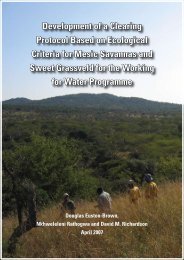INFORMATION DOCUMENT - DWA Home Page
INFORMATION DOCUMENT - DWA Home Page
INFORMATION DOCUMENT - DWA Home Page
Create successful ePaper yourself
Turn your PDF publications into a flip-book with our unique Google optimized e-Paper software.
Instream Flow Requirements: Theory and Practice<br />
The analysis of environmental flow requirements is based on the premise that river flow is the primary determinant of a number<br />
of physical and biological parameters in aquatic and riparian ecosystems. A crucial relationship exists between river flow or<br />
discharge (analyzed as a number of components, notably base flows and floods), hydraulics and geomorphology. The volume<br />
of flow determines the depth and size of the river and a number of ecological processes are linked to this.<br />
An IFR is a description of a modified flow regime, invariably due to the presence of a control structure in the river, such as a<br />
dam or weir, that is linked to a description of the condition or health of the river that this flow might be expected to produce.<br />
Furthermore, because the characteristics of a river change as one moves downstream, flow-ecology relationships change too.<br />
One must, therefore, establish different relationships for each affected river reach. Thus, IFR studies focus their analyses on<br />
carefully selected IFR Sites, representative of particular river reaches (the LHWP IFR Phase 1 Sites are shown in the map on<br />
<strong>Page</strong> 1).<br />
In Southern Africa, the Building Block Methodology (BBM) has been developed and used for the assessment of IFRs. The BBM<br />
requires that a desired future state of the river be identified first; then the scientists<br />
construct the seasonal flow regime, comprising base flows, small and large floods,<br />
required to maintain that desired state. In the case of the LHWP, the in-stream<br />
flow assessment (IFA) was needed to assist in determining a desired future state,<br />
not the other way round, so a different approach was developed. This Downstream<br />
Response to Imposed Flow Transformations (DRIFT) methodology allows the<br />
biophysical and socio-economic consequences of flow changes to be determined<br />
for a number of potential future flow regimes. That is, it is a scenario-based approach.<br />
A Caveat. It is important to bear this in mind when reading the findings of these<br />
studies, that the findings are based on a specific set of conditions defined as<br />
the scenario and not on actual conditions. The findings are, thus, all predictions<br />
and are only as good as the primary information or databases that support them.<br />
For instance, the assessment of changes in riparian vegetation patterns requires<br />
a detailed knowledge of the auto-ecology of individual species, but such data<br />
are not available for the Highlands environment and species specifically, although<br />
experience in other systems will be applicable to some extent. The results of<br />
these studies must, therefore, be interpreted with caution; they must not be viewed<br />
as fact, but rather as the best predictions currently available. Careful monitoring<br />
of the system, after implementation of the IFR Policy, will be essential to establish<br />
the actual system responses, to establish actual losses to resource users and to<br />
permit adaptation as necessary.<br />
The LHWP IFR analysis proceeded on the basis of eight IFR sites in the four rivers<br />
of interest (see Map). Detailed, holistic field characterizations of each site field<br />
were undertaken over a 12-month period to establish a baseline, although a preproject<br />
baseline for the Malibamats’o River could not be established, due to the<br />
presence of Katse Dam. The DRIFT methodology was then used to predict the<br />
effects on different biophysical system components. Four modified flow regimes<br />
were hypothesized, based on design and operational constraints and the nature of<br />
the rivers. Finally, the consequences of the predicted biophysical changes on the<br />
human Population at Risk were analyzed and the costs of potential resource losses<br />
were calculated.<br />
Bringing all the<br />
elements together<br />
The final phase of policy development<br />
will be to assess the trade-offs between<br />
river health, communities and the<br />
implications of different release options<br />
in terms of lost benefits to the two<br />
countries – all within the context of the<br />
Treaty requirement that the project<br />
should “pay due regard to the<br />
maintenance of the welfare of persons<br />
and communities”, and “take all<br />
reasonable measures to ensure…the<br />
protection of the existing quality of the<br />
environment”. If a purely financial<br />
approach were to be taken, the project<br />
would maximize revenue at the expense<br />
of the downstream environment and<br />
communities; if a purely environmental<br />
approach were to be taken, the project<br />
would release as much water as was<br />
necessary to protect the environment<br />
and communities at a high cost in terms<br />
of lost revenue. The policy development<br />
process seeks an intermediate position<br />
that will represent a fair and reasonable<br />
balance between the two extreme<br />
positions.<br />
5
















